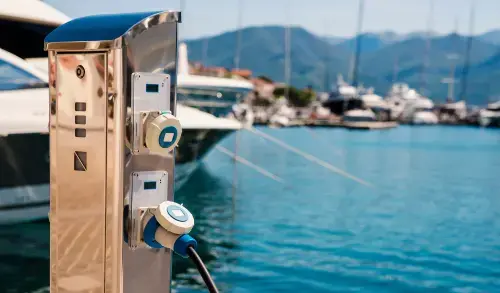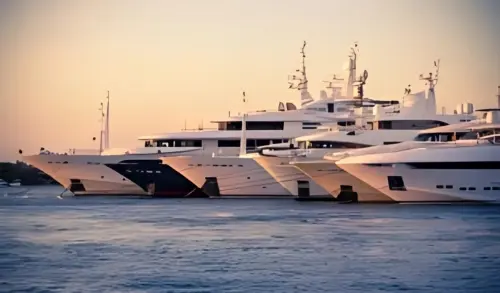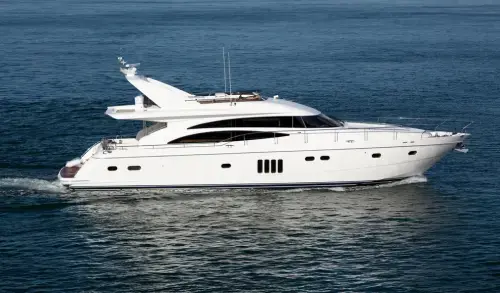Shore Power in U.S. Marinas: Availability & Challenges of 208V 3-Phase
Modern vessels rely heavily on consistent, reliable electrical power, especially when docked. Rather than running generators at the marina, most...
5 min read
Atlas Marine Systems : May 7, 2025 9:45:00 AM

Modern yachts are more power-hungry than ever before. High-capacity HVAC systems, advanced navigation electronics, stabilized platforms, and hotel loads place increasing demands on electrical infrastructure, especially when docked.
A common bottleneck lies in the interface between the vessel and the marina: the marine shore power cord. When available shore power doesn’t match a vessel’s electrical needs, the result is compromised system performance, tripped breakers, and a frustrating user experience.
For large yachts navigating globally or docking in marinas with inconsistent shore power availability, dual marine shore power cord input converters offer a sophisticated solution that increases flexibility, power capacity, and operational resilience. This article explores the limitations of traditional single-cord systems and dives into the engineering advantages of dual-input systems to optimize your operations.
Marina infrastructure varies widely around the world, not only in voltage and phase configuration but also in available current capacity. In many cases, a single marine shore power cord cannot supply sufficient current to meet a yacht’s full electrical load. This forces operators to manually manage load shedding, such as disabling HVAC or galley systems to avoid overloading the cord or tripping the marina breaker.
This issue is especially pronounced at low voltages. Because power is a function of voltage and current (P = V × I), supplying the same onboard load at 208V requires nearly double the current compared to a 400V source. This means more stress on connectors and breakers, greater heat generation, and a higher likelihood of nuisance tripping.
Furthermore, a single-cord setup reduces operational flexibility. Suppose a single marina outlet is underpowered or incompatible with the vessel’s input configuration. In that case, the yacht may be unable to connect to shore power, relying instead on onboard generators, resulting in increased fuel usage, emissions, and wear on mechanical systems.
A dual marine shore power cord input converter features two fully isolated input stages and a single regulated output. Unlike traditional converters that accept only one shore connection, a dual input converter can draw power from two independent marina outlets, which may differ in voltage, phase, and amperage.
Critically, these input stages are galvanically isolated. This isolation allows the system to safely connect to shore supplies protected by ground fault circuit interrupters (GFCIs), eliminating nuisance trips and compatibility issues. The converter intelligently detects the voltage and phase on each input and configures itself accordingly, whether one or both.
When only one cord is connected, the converter routes power from that source to both input sections internally. If a second cord is plugged in later, the converter automatically transfers one of the input stages to the new source without interrupting power delivery to the yacht.
A dual input converter is far more than a convenience—it’s a strategic solution to the limitations imposed by single-cord systems. Let’s explore some of the most significant advantages.
One of the most significant engineering advantages of a dual shore power converter is its ability to implement proportional load sharing. If a marina provides outlets with different amperage ratings—say 100A and 50A—the converter doesn’t split the load evenly. Instead, it intelligently assigns approximately two-thirds of the total load to the 100A source and one-third to the 50A source, maximizing available capacity while avoiding overdrawing either leg.
Without this feature, load sharing defaults to a 50/50 split. In the example above, the system would be constrained to just 100A of usable power, limited by the 50A breaker, despite 150A technically available. Proportional load sharing enables yachts to draw maximum power from mixed shore power environments without risking tripping marina breakers.
This capability is unique to true dual-input converters. Attempting to use two single-cord converters in parallel doesn’t support proportional sharing and introduces additional complexity, reduced reliability, and mandatory dual-cord operation.
A dual marine shore power cord setup enhances the system's thermal and electrical efficiency. By spreading the total current draw over two cords—especially during high-load scenarios—each cable carries less current, reducing resistive heating in the conductors, connectors, and breakers. This translates directly to longer service life for those components and lower power losses across the shore power delivery system.
Reduced heating is particularly important for cable reels and connectors, which are often the most thermally vulnerable parts of the system. Over time, thermal cycling can degrade contact surfaces, insulation, and breaker performance. By reducing these stresses, a dual input converter helps preserve the integrity of the entire marine shore power cord interface.
Dual-input converters don’t just increase available power—they act as power conditioners. Once incoming power is accepted, the converter outputs a clean, regulated voltage and frequency to the yacht’s distribution system, protecting sensitive onboard electronics from the effects of fluctuating or noisy marina supplies.
Voltage drops, phase imbalances, and minor frequency variations are common at older marinas or those with overloaded circuits. The converter isolates the yacht from these issues, providing a stable electrical environment that minimizes wear on motors, reduces nuisance alarms, and ensures the proper function of critical systems.
Dual-input converters are engineered for global shore power compatibility, directly affecting safety. While not all systems explicitly list frequency or plug type compatibility, converters of this class are typically engineered to support:
Support for both 50Hz/60Hz input
Operation across IEC/NEMA plug types
Relevance for CE or other certifications
Despite their increased capability, dual-input converters typically share the same footprint as their single-cord counterparts. This makes them an excellent option for retrofitting, particularly on yachts with a cable reeler for the primary cord and a wish to add a secondary connection for flexibility.
Importantly, the two shore cords do not need to be the same type. They can differ in phase, voltage, and current capacity. The converter will identify each connection and adapt accordingly. For operators traveling internationally or frequenting varied marinas, this is an invaluable level of adaptability.
Use cases where dual converters excel include:
High-load yachts that require over 100A of continuous power.
Global cruisers are docking in regions with non-standard shore power infrastructure.
Charter vessels that require full functionality during guest stays.
A dual marine shore power converter is a passive device in many respects. With no moving parts beyond internal cooling fans, these units require minimal upkeep. A simple annual inspection is typically sufficient to maintain performance and longevity.
Modern units also incorporate internal current sensing and monitoring features. If a high current draw approaches the limit of the connected cord, the system will alert the crew, prompting the connection of the second cord before protection devices trip. This adds a layer of predictive maintenance and intelligent response, improving operational awareness.
One common misunderstanding is the assumption that both cords must always be connected. In reality, the converter functions perfectly with a single cord, routing that input to both internal stages. The second cord simply provides additional capacity when needed. This is a significant usability advantage over a dual single-cord system, requiring both cords to function properly.
Another key consideration is planning ahead. Yacht owners and operators should be aware of the power configurations at their most frequented marinas. If underpowered or mixed-voltage outlets are common, investing in a dual marine shore power cord converter will yield long-term operational flexibility and comfort.
Atlas Marine Systems is the global leader in advanced marine electrical solutions, including dual marine shore power cord input converters. With decades of experience engineering shore power systems for superyachts, naval vessels, and expedition-class boats, Atlas provides converters that combine precision, robustness, and intelligent automation.
Our dual-input converters feature:
True galvanic isolation for each input stage
Seamless auto-switching and detection
Proportional load sharing for maximum available power
Compatibility with global marina power configurations
Retrofit-ready enclosures and simplified integration
Atlas converters are backed by global technical support, long-term reliability, and a commitment to delivering uninterrupted, clean power wherever your yacht travels.
Contact Atlas Marine Systems for engineering support, specifications, or a quote customized to your yacht’s needs. When power matters, choose a converter engineered for reliability and built for real-world marine environments. We deliver the performance you need—when and where you need it most.

Modern vessels rely heavily on consistent, reliable electrical power, especially when docked. Rather than running generators at the marina, most...

The ShorPOWER SHF system is one of the most dependable and versatileelectrical shore power convertersystem models available today. The ShorPOWER...

For modern yachts, power systems demand more than compatibility; they require precision, thermal efficiency, and smart integration with onboard...